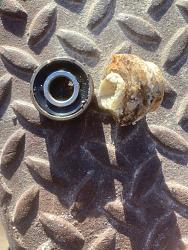
Originally Posted by
Ed Weldon

Pretty clever. Thinking about this I'm recalling somewhere reading about how the paper towel makers have been changing the mix of materials to include fine filaments that add substantially to the wet strength of the towel. I think this is the key to it all. When sufficiently packed into the confined space the wet towel material essentially solidifies sealing the insides of the ball bearing and turning it into a piston of sorts. You can't do this with plain grease or any other true liquid material that will simply be forced past the bearing shields (or seals as the case might be) by the "hydraulic pressure" created by the hammer blows and the high pressure shock wave that they produce.
The bottom line here is that a combination of knowledge of basic physics and strength of materials is critically important to the skill development of all mechanical technicians and not just the engineering types (like me). Not that tribal knowledge isn't important. But an understanding of underlying science can save a lot of trial and error.



 LinkBack URL
LinkBack URL About LinkBacks
About LinkBacks


 Reply With Quote
Reply With Quote





Bookmarks